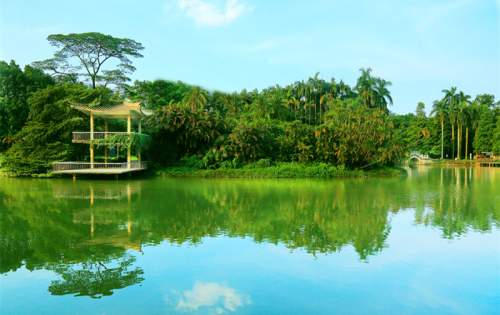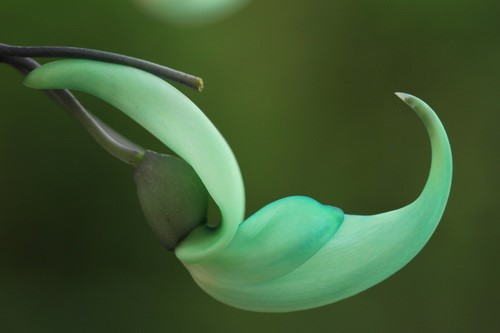

South China Botanical Garden, CAS
South China Botanical Garden (SCBG), Chinese Academy of Sciences (CAS) is one of the oldest botany research institutions in China. SCBG, formerly known as the Institute of Agriculture and Forestry (IAF), Sun Yat-Sen University, was founded in 1929 by renowned botanist Academician Chun Woon-Young. In 1954, the affiliation of IAF was changed to CAS and was renamed South China Institute of Botany (SCIB), CAS. In 2003, SCIB was renamed to its current name SCBG. In 2022, SCBG was upgraded to South China National Botanical Garden (SCNBG) as one of the first two National Botanical Gardens launched and approved by the State Council of China. During the period of SCIB, China's first national nature reserve--the Dinghushan National Nature Reserve was established in 1956.
As one of the largest comprehensive gardens and one of the top plant germplasm conservation institutions in China, SCBG consists of three divisions:
1.Display zone. Occupying an area of 282.5 ha, it was designed mainly for plant ex-situ conservation. So far there are about 17,502 taxa growing in 38 theme gardens including Magnolia garden, Ginger garden, Orchids garden etc. The Longdong Qilin Scenic spot and the conservatory group are two most outstanding landscapes of this garden.
2. Research zone. Covering an area of 36.8 ha. It contains 3 research centers, including Plant Science Center, Ecology & Environmental Science Research Center, and Agriculture & Biotechnology Research Center. The herbarium with more than 1,150,000 plant specimens, a library, the editorial office of Journal of Tropical and Subtropical Botany, an information center and a public laboratory with CMA and CNAS dual qualification certification have been supporting the research of this garden and other institutions at home and abroad.
3. Dinghushan National Nature Reserve. With an area of 1,133 ha, it is the first national nature reserve in China and the only nature reserve affiliated to CAS. Currently, over 2,291 plant species are in situ conserved in this nature reserve.
In addition, SCBG has some field stations and laboratories to support its research and conservation, including 2 national/CERN field stations (Dinghushan Station and Heshan Station), one CAS/provincial field station (Xiaoliang Station) and one provincial field station; 3 key laboratories of CAS (plant resource conservation and sustainable utilization, vegetation restoration and management of degraded ecosystems, as well as molecular analysis and genetic improvement of agricultural plants in South China), one engineering laboratory of the CAS (vegetation on ecosystem restoration on islands and coastal zones); 2 key laboratories of Guangdong Province (digital botanical garden, applied botany); one Guangdong Engineering Technology Research Center (development of characteristic plant resources),Guangdong Provincial Germplasm Resource Bank, and South China Plant Identification Center.
Meanwhile, SCBG is also the host of some international and local associations, including Botanic Gardens Conservation International (BGCI) China Program Office, Secretariat of International Association of Botanic Gardens (IABG), the World Magnolia Center, Botany Society of Guangdong province, Plant Physiology Society of Guangdong province, and Ecology Society of Guangdong Province.
Since affiliated to CAS in 1954, SCBG has made great achievements in the scientific research, which includes about 500 monographs such as Flora of China, The Vegetation of Guangdong, Studies on the Tropical and Subtropical Degraded Ecosystem and Its Rehabilitation, Rare Plants of China, and Introduction to Restoration Ecology , Over 5,300 published SCI papers including highly prestigious journals such as Nature and Science, more than 460 authorized patents, and more than 260 granted or registered new plant varieties since 1988.
Based on those research achievements, more than 320 prizes have been awarded at various levels, such as the first prize in China's State Natural Science Award and China's State Scientific and Technological Invention Award, and "Top Ten Basic Research News in China" in 2000 and 2006, respectively.
SCBG would not have made so many achievements without talents. By the end of 2022, SCBG has 412 staff members (67 professors and 97 associate professors) and 82 postdoctoral staff, which includes various talents, 3 recipients of National Science Fund for Distinguished Young Scholars,3 recipient of National Outstanding Youth Science Foundation,3 recipients of Young and Middle-aged Science & Technology Innovation Leaders in the Innovation Talent Promotion Program by the Ministry of Science & Technology, 6 National Science & Technology Innovation Leading Talents and Young Top-notch Talents, as well as 10 introduced talents of CAS Talent Introduction Program.
SCBG has paid special attention to the cultivation of the talents in relevant fields. It is one of the first batch of Master’s degree training units approved by the Academic Degrees Committee of the State Council. At present, there are 4 authorized Doctor degree disciplines (botany, biochemistry & molecular biology, genetics and ecology), 7 authorized Master degree disciplines (botany, biochemistry & molecular biology, genetics, ecology, ornamental plants & horticulture, wildlife conservation & utilization, biological & medicinal chemistry), 2 postdoctoral research station of first-level disciplines (biology, ecology). By the end of 2022, there are 461 enrolled graduate canditates (295 Master candidates and 166 Doctoral candidates). A great number of awards and honors have been achieved by students each year, including National Excellent PhD Dissertations (2 dissertations) and CAS Excellent PhD Dissertations (7 dissertations).
As a National AAAA Tourist Attraction, SCBG receives over one million visitors per year. SCBG has paid great attention to knowledge dissemination and science popularization education. In 1997, SCBG built the first popular science education base in China, "Guangdong Botany Science Popularization Base" was jointly built with the Guangdong Provincial Association for Science and Technology; 36 science popularization bases have been built, including "National Science Popularization Education Base", "National Practice Education Base for Primary and Secondary School Students" and "National Science Popularization Base for Scientific Research"; In 2002, completed "Pugang Natural Education Path", it was the first natural education path in China. Besides, SCBG held various kinds of popular science training and large-scale popular science activities throughout the year, including ‘Qilin Science Forum’, ‘Nature Observation’, ‘Nature Notes’ etc. Dinghushan Nature Reserve has built science and education facilities such as "see Dinghushan" theme exhibition Room, nature education path and 3D model of Ginger flower, and launched exploratory nature education courses such as "natural forest" and "small citizen scientist". SCBG was awarded as National Popular Science Education Base, the Most Popular Base for Popular Science in Guangzhou, and Patriotic Education Base of Guangzhou. SCBG was voted as the best botanical garden of China in both 2019 and 2022.
The mission statement of SCBG: to position itself in South China, devoted to plant conservation, scientific research and knowledge dissemination of the tropical and subtropical regions of the world, to build into a high-level research institution in botany, ecology, agricultural science, key technologies for plant resource conservation and utilization, as well as to lead the development of the national botanical garden system in China, so as to provide scientific and technological support for the green development of China.

Main Entrance of SCBG

Longdong Qilin

Birdview of the Greenhouses

Lake and Yiran Pavilion

The Research Zones

Dinghushan National Natural Reserve

